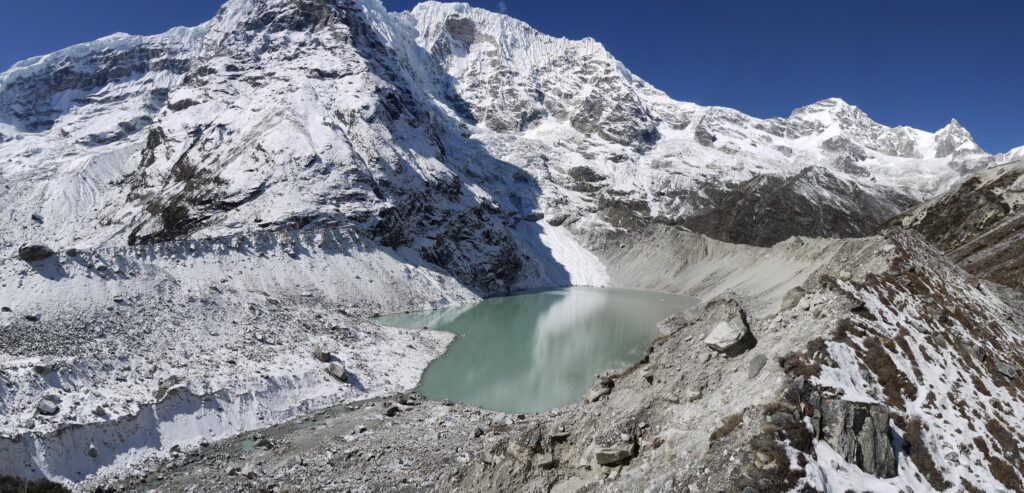Syllabus
GS 1: Important Geophysical phenomena
Context:
Recently, a new study has raised concerns over the increasing number of floods in the Hindu Kush Himalayan region.
More on the News
- Scientists from the International Centre for Integrated Mountain Development (ICIMOD) have raised concerns over the increasing number of glacial-origin floods in the Hindu Kush Himalayan region.
- This alarming trend is linked to rising global temperatures, which are accelerating glacier melt and increasing the risk of disasters such as Glacial Lake Outburst Floods (GLOFs) in the region.
About Glacial Lake Outburst Floods
- A Glacial Lake Outburst Flood (GLOF) occurs when a large volume of water is suddenly released from a glacial lake, usually formed by melting glaciers.
- This sudden release can be triggered by factors such as ice or rock avalanches, earthquakes, or the collapse of the natural dam (usually made of ice or loose moraine) holding the water.
- GLOFs can cause catastrophic flooding downstream, damaging infrastructure, displacing communities and posing serious risks to life and the environment.
- Glacial floods are mainly driven by rising temperatures. Continuous warming causes glaciers to melt and glacial lakes to expand.
- Sudden temperature spikes can trigger events like ice avalanches, ice break-offs (calving), or slope failures due to melting of permafrost — ground (soil, rock, or sediment) that stays frozen for at least two years.
- These events increase the risk of glacial lake outburst floods (GLOFs) in mountain regions.
Key Highlights from the Study
In the 2000s, glacial floods in the Hindu Kush Himalayas occurred once in 5–10 years. However, in just May and June 2025, ICIMOD recorded three such floods — in Nepal (Limi), Afghanistan (Andorab Valley), and Pakistan (Chitral and Hunza).
This sharp rise is unprecedented and highlights the urgent need to study the causes and manage the risks in the region.
ICIMOD has noted a new trend in recent GLOF events: they are now being triggered by the sudden draining of newly formed ice-dammed supraglacial lakes.
- An example is the flood this week in Bhotekoshi Nadi in Rasuwa (Nepal) is caused by the outburst of such a lake. This highlights the growing risks from unstable glacial formations in a warming climate.
Researchers have stressed the need to strengthen mapping and monitoring of glacial lakes in the Hindu Kush Himalayas.
They recommend updating inventories of potentially dangerous lakes, analysing small and short-lived ice-dammed lakes and including glacier retreat and lake formation processes in hazard assessments.
According to ICIMOD, current monitoring tools are inadequate for the vast and rapidly changing terrain.
It also highlighted the urgent need for better systems to track these changes.
Researchers also warn that by 2100, the region could see a three-fold increase in GLOF risk, making early detection and preparedness even more critical.
About Supraglacial lakes
- Supraglacial lakes form on the surface of glaciers, mainly in debris-covered areas.
- They start as small meltwater ponds and gradually expand, sometimes merging to form larger lakes.
- These lakes are highly dynamic and can become unstable, increasing the risk of sudden outburst floods.
- These lakes are difficult to detect, especially the smaller or short-lived ones.
- Free satellite data like Landsat and Sentinel-2 have limited resolution and can usually spot only larger lakes.
- This means many smaller lakes may go unnoticed. High spatial resolution in satellite imagery is crucial for accurately identifying and monitoring these glacial water bodies.
About Hindukush Mountain

The Hindu Kush is a mountain range in Central and South Asia, primarily spanning:
- Eastern and Central Afghanistan
- Northern Pakistan (Chitral, Gilgit-Baltistan)
- Southern Tajikistan
Length: ~800 km
Orientation: Runs east to west, merging with the Pamir Mountains in the northeast.
Considered the western extension of the Himalayas, though geologically distinct in formation.
Formed as a result of the collision between the Indian Plate and Eurasian Plate.
Lies within the Himalayan-Alpine orogenic belt which is one of the world’s most seismically active zones:
- Prone to earthquakes and landslides
- Undergoes tectonic uplift and faulting



